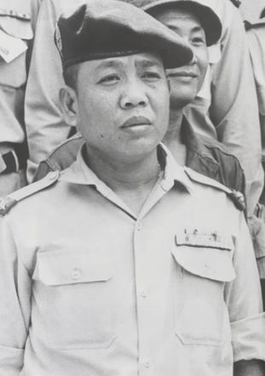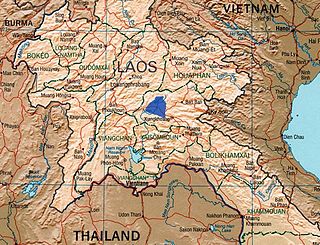Related Research Articles

Major general Phoumi Nosavan was a military strongman who is a prominent figure in the history of the Kingdom of Laos. At times, he dominated its political life to the point of being a dictator.

Captain Kong Le was a Laotian paratrooper in the Royal Lao Army. He led the premier unit of the Royal Lao Army, 2ème bataillon de parachutistes, which campaigned relentlessly during 1959 and 1960. The idealistic young American-trained Lao Theung officer became known worldwide when on 10 August 1960 he and his mutinous paratroopers overthrew the Royal Lao Government in a coup d'état. He declared he aimed at an end to government corruption; to the shock of American officials, he declared U.S. policies were responsible for the ongoing fraud.

Major General Kouprasith Abhay was a prominent military leader of the Kingdom of Laos during the Laotian Civil War. Scion of a socially prominent family, his military career was considerably aided by their influence. In early 1960, he was appointed to command of Military Region 5, which included Laos' capital city, Vientiane. Removed from that command on 14 December for duplicitous participation in the Battle of Vientiane, he was reappointed in October 1962. He would hold the post until 1 July 1971, thus controlling the troops in and around the capital. Over the years, he would be involved in one way or another in the coups of 1960, 1964, 1965, 1966, and 1973. His service was marked by a deadly feud with another Laotian general, Thao Ma; the feud was largely responsible for the latter two coup attempts against the government.
The Programs Evaluation Office was a covert paramilitary mission to the Kingdom of Laos, established on 13 December 1955 by the United States Department of Defense. The 23 July 1962 International Agreement on the Neutrality of Laos would cause it to be shut down in September 1962. It would be succeeded by the Requirements Office.

The Royal Lao Armed Forces, best known by its French acronym FAR, were the official armed defense forces of the Kingdom of Laos, a state that existed from 1949 to 1975 in what is now the Lao People's Democratic Republic. First created under the French protectorate of Laos on July 1, 1949, the FAR was responsible for the defense of the Kingdom since its independence in October 1953 from France, until its dissolution on December 2, 1975. It operated notably during the North Vietnamese invasion of Laos and the Laotian Civil War from 1960 to 1975.
The Battle of Luang Namtha, fought between January 1962 and May 1963, was a series of clashes in the Laotian Civil War. It came about as a result of the turmoil following Laotian independence as a result of the First Indochina War with France. The Kingdom of Laos had foreign soldiers on its soil, and a political struggle in progress concerning those outside troops. Following a coup and counter-coup that left General Phoumi Nosavan in charge, the general decided on military action to settle the political issue of interlopers in Laos.
Operation Hardnose was a Central Intelligence Agency-run espionage operation spying upon the Ho Chi Minh trail that began during the Laotian Civil War. Started in Summer 1963, it soon attracted the attention of the U.S. Secretary of Defense, Robert McNamara. By December 1963, he was calling for its expansion. Operation Hardnose expanded and continued to report on the Ho Chi Minh trail even as American military intelligence activities mounted against the communist supply artery. In an attempt to adapt technology for use by illiterate Lao Theung, some of the U.S. Air Force's survival radios were modified by the CIA for use by their spies.
Operation Toan Thang was the first communist wet season offensive of the Laotian Civil War. Launched on 18 June 1969 and successful by the 27th, the assault by People's Army of Vietnam troops from the 312th Division and sappers of the 13th Dac Cong Battalion captured Muang Soui. Although the defenders outnumbered the assailants by three to one, the only hard surfaced airfield near the Plain of Jars would fall to the communists, depriving the defending Royal Lao Government of its only forward fighter-bomber base.
The Battle of Vientiane was the decisive action of the 1960 Laotian coups. Fought between 13 and 16 December 1960, the battle ended with General Phoumi Nosavan winning control of the Kingdom of Laos with the aid of the Royal Thai Government and the U.S. Central Intelligence Agency. Vientiane was left devastated by the fighting, with about 600 civilians dead, about the same number of homes destroyed, and 7,000 left homeless. The losing Forces Armées Neutralistes under Captain Kong Le retreated onto the strategic Plain of Jars, to begin an uneasy coexistence with the Pathet Lao and the invading People's Army of Vietnam.
Major General Sourith Don Sasorith was a Royal Lao Government commanding officer during the Laotian Civil War. Appointed to command the Royal Lao Air Force on two occasions, he was also entrusted two other times with command of a Military Region. At the war's end in 1975, Sourith Don Sasorith was condemned to a communist re-education camp.
The 1966 Laotian coup d'état was brought about by political infighting concerning control of the Royal Lao Air Force, and use of its transports for smuggling. General Thao Ma, who wished to reserve the transports for strictly military use, was forced into exile on 22 October 1966 by fellow generals angling to use the transports for smuggling opium and gold.
Operation Junction City Jr. was a major Laotian offensive of the Vietnam War; initially aimed at temporary disruption of the Ho Chi Minh Trail, it was extended into an attempt to isolate the major North Vietnamese communist transshipment point at Tchepone from the units it was supposed to supply.
Project Waterpump was a secretive support operation by the U.S. Air Force to train and nurture into existence the Royal Lao Air Force (RLAF). The United States had decided to covertly support the Kingdom of Laos in the Laotian Civil War as the Lao fended off a North Vietnamese invasion. The nascent RLAF was seen as a force multiplier but needed pilots and technicians. The 40-man Detachment 6, 1st Air Commando Wing, code named Waterpump, was forwarded to Udorn Royal Thai Air Force Base for this training duty in March 1964. They would remain on duty through the truce of 21 February 1973. Their first hasty assignment was transition training to the T-28 Trojan for American civilian pilots; the resulting A Team would exist through 1967. The Air Commandos also conducted final training for Royal Thai Air Force (RTAF) mercenary pilots; the resultant B Team would serve until 1970. Besides putting a polish on graduate pilots, the Waterpump detachment trained Lao pilots from scratch. The RLAF's high pilot casualty rate made bringing the RLAF rosters up to strength a long grind.
Operation Snake Eyes was a proposed military operation of the Laotian Civil War. Planned in mid-December 1969 by the U.S. Ambassador to Laos, the planned interdiction of the newly constructed Chinese Road, Route 46, was aimed at halting the road's progress toward the border with Thailand. The offensive by guerrilla raiders was delayed six months for operational reasons. When it was finally ready to be launched, it was pre-empted by the furor caused by the Cambodian Incursion. Fearful that Operation Snake Eyes would arouse even greater publicity, the Central Intelligence Agency handlers of the guerrillas canceled the operation on orders of the White House. Attempts to limit Chinese expansion toward the south would be left to future operations, such as Operation Phalat and Operation Sourisak Montry.
The Chinese Road were a series of highways built as a foreign aid project by the People's Republic of China (PRC) in northern Laos, beginning in 1962. The first new road was built from Mengla, Yunnan Province, PRC to Phongsali, Laos; it was completed on 25 May 1963. The next major road built was Route 46, begun in the 1966 dry season and stretching from the southern tip of Yunnan Province southward toward the border of the Kingdom of Thailand. As 25,000 Chinese troops and 400 antiaircraft guns came to be posted to defend Route 46, and Thai support of American war efforts in both the Laotian Civil War and the Vietnam War became widely known, there was uneasiness among both Thai and American intelligence communities concerning Communist China's intents in constructing the all-weather highway. American interest in the new road extended up to the White House.
Operation Sourisak Montry VIII was a Thai military offensive against an encroaching Chinese Communist presence just north of the Mekong River. Operation Phalat established a base camp at Xieng Lom, Laos, on the southern bank of the Mekong River, and garrisoned it with three Thai mercenary battalions. Operation Sourisak Montry was a series of indecisive skirmishes in the same area, during which the Thais won a Pyrrhic victory over the Pathet Lao in mid-March 1972.

Campaign Z was a military offensive by the People's Army of Vietnam; it was a combined arms thrust designed to defeat the last Royal Lao Army troops defending the Kingdom of Laos. The Communist assault took Skyline Ridge overlooking the vital Royalist base of Long Tieng and forced the restationing of Royalist aviation assets and civilian refugees. However, Communist forces eventually receded back onto their lines of communication without capturing the base.
Operation Strength II was a Royalist military offensive of the Laotian Civil War. It was devised as another diversion in the mode of the original Operation Strength. Planned as a pincer movement on the Plain of Jars, Operation Strength II's beginning was grossly hampered by combat refusals and desertions from one of its two task forces. Loss of tactical air support as the Easter Offensive began in South Vietnam also weakened the Laotian effort. In any event, neither pincer did much toward its goal of distracting the People's Army of Vietnam from its attempts to overrun the strategic guerrilla base at Long Tieng and end the war.
Operation Phou Phiang III was the final offensive of the Laotian Civil War by the Royal Lao Army's L'Armée Clandestine. Central Intelligence Agency-sponsored Hmong guerrillas and Thai mercenaries formed three attacking task forces in an attempt to clear the People's Army of Vietnam from positions near the Royalist guerrillas' headquarters on the Plain of Jars. All three columns failed to move the Vietnamese invaders before the ceasefire of 21 February 1973 ended the war.
Unity was the code name for Thailand's covert supply of mercenary soldiers to the Kingdom of Laos during the Laotian Civil War. From 4 July 1964 until March 1973, battalions of Thai volunteers fought Communist insurgents on the Plain of Jars in Military Region 2. As the Hmong L'Armée Clandestine was sapped by ongoing casualties and a limited basis for replacements, Unity battalions replaced them.
References
- Anthony, Victor B. and Richard R. Sexton (1993). The War in Northern Laos. Command for Air Force History. OCLC 232549943.
- Castle, Timothy N. (1993). At War in the Shadow of Vietnam: U.S. Military Aid to the Royal Lao Government 1955–1975. ISBN 978-0-23107-977-8.
- Conboy, Kenneth and James Morrison (1995). Shadow War: The CIA's Secret War in Laos. ISBN 978-1-58160-535-8.